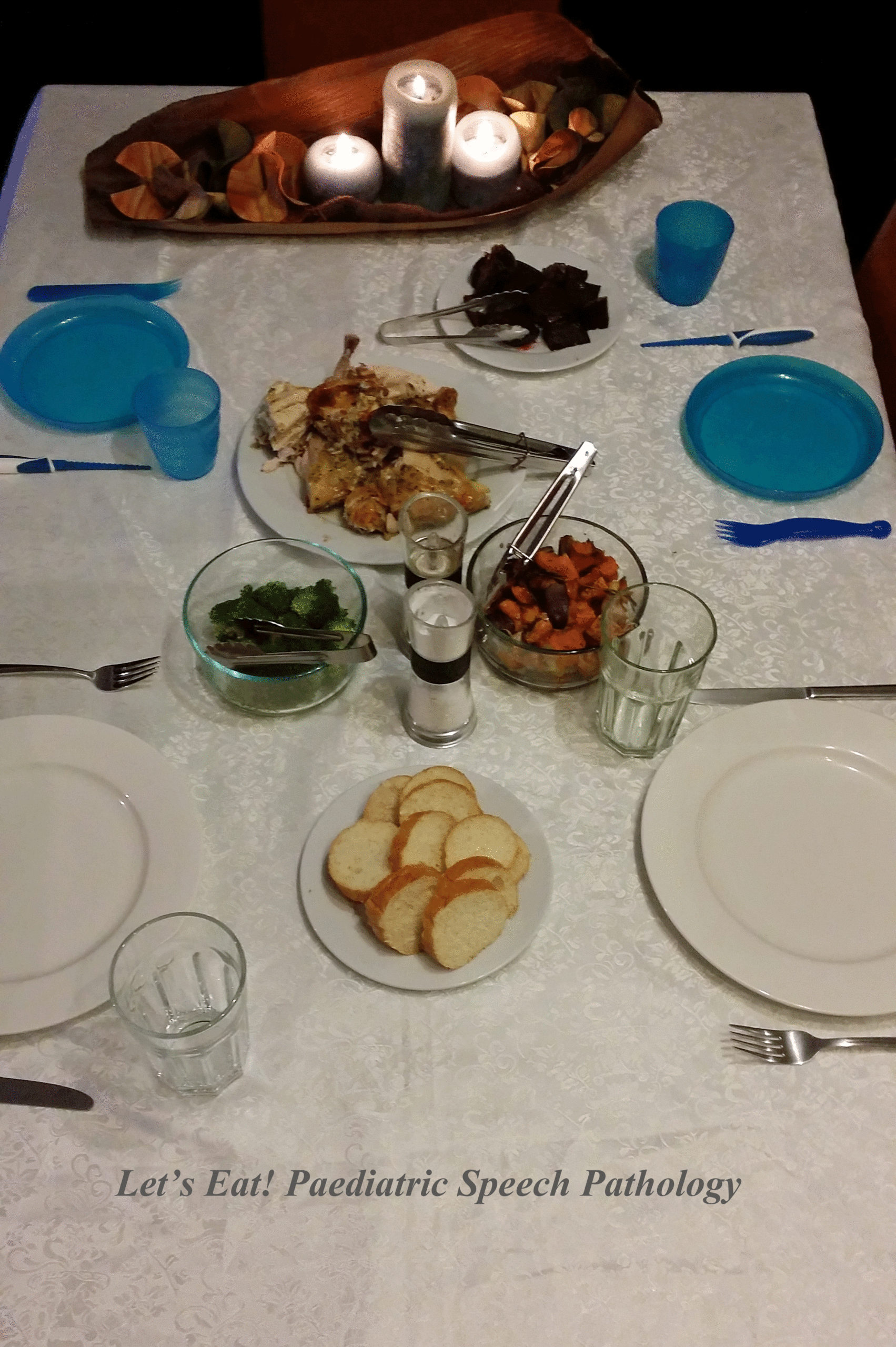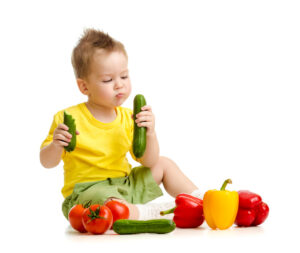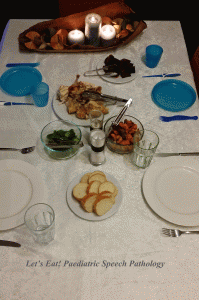
Christmas is such a delicious nourishing eating time for most people (eg prawns, ham, yummy salads and our Aussie pav – what could be better!). However for fussy eaters, it can be an anxiety filled situation where parents feel pressured to either force their child to eat like everyone else or find themselves defending their child’s feeding issues to family members in front of their children.
So how can we avoid the confrontation while still enjoying the food with our family and friends? And more specifically – how can we create positive sensory memories for our children with food – fussy eaters or not as well as create opportunities for our fussier children to be involved with the family meal? … I say, let’s plan it now and avoid mealtime tantrums as much as we can – here are my top tips to survive those Christmas family meals….
1. Prepare your child before going out– explain that there will be lots of food and you will make sure that there is at least one thing on the table that they can eat. Back this up by chatting with the host before the event, find out what food is being served and make sure there is at least one option (eg bread) that your child eats on the table.
2. Before the meal– rather than saying ‘dinner is ready, come to the table’, give your child a reminder/warning- you could say ‘dinner will be ready in 5 minutes, let’s wash our hands and get ready’. This gives them some time to prepare themselves and hopefully reduce anxiety when everyone rushes to the table.
3. During the meal– Smile and be positive around your child and everyone else- your child will feel your anxiety so take a breath and smile – remember the meal is more than just about the food! Please try not to label your child as the “fussy eater” in front of them or even respond for him if someone else offers him a new food (eg “Jack won’t eat that, he’s a bit fussy with foods”) instead, pause, hold your breath and you might be surprised, if other children are eating it, your child might just try it! Scroll to the end of the post for some key phrases to use with family members….
4. On that note, please don’t bring your own meal for your child, it will further alienate him from everyone else and draw more attention to the situation. More importantly, it will never expose him to different foods. If you are very worried that all he has eaten for Christmas lunch is bread, then offer him a nutritious afternoon tea or supper when you get home.
5. I am a big fan of family style serving (or buffet style in Australia)- this is where all the food is on the table in small bowls and everyone passes it around to serve each other. What great exposure time for your child to learn – smell, see and interact with food (even if they don’t eat it). Don’t dismiss this learning step – it’s not about if they ate something new or not, it’s about helping them move up the “learning about a new food” steps like seeing other people eat it, smelling it and even helping pass the bowl around – small but important steps.
6. Lastly, don’t forget your mantra (Ellyn Satter’s division of responsibility) backed with 30 years of evidence based research – this stuff really works, I promise!
Your role-
– decide when your child eats eg 12pm for lunch
– where they eat eg hopefully at the dining table with everyone else
– what they eat eg “think” point – serve foods that YOU want to eat as well as foods your CHILD may want to eat, this can be as small as having a bit of crumbed chicken/nuggets on the table along with the roast chicken).
Your child’s role
– what they eat (so it’s totally up to them if they just eat fruit and bread and nothing else- this is not your decision, it’s theirs and it’s a rule that is important to honour in this trust based approach).
– how much they eat (not forcing them on how much they have to eat or what types of food they have to eat before they can leave the table – please!!)
8.Some of my patients have already started to understand about “food links” (eg white bread rolls are similar to white sliced bread) so might be more ready to try a new food if it has similar properties to a food in their already “accepted” range. If your child is like this, then encourage them to pick something new to put on their plate (explaining the common link e.g. “it’s a bit like white slice bread on the inside but it looks like a bread roll on the outside”) and also reassure them that they don’t have to eat it if they don’t want to even if they put it on their plate). Have this chat with them (eg “John, remember how we are linking new foods? If there is something there I think you might like, I will quietly point it out to you and then you can decide if you feel ready to eat it) before you head out to the family member’s house.
9. To offer dessert or not to offer it is totally up to you but please don’t make your child finish their plate for dessert (or even have 4 more mouthfuls – what does that prove?) and please don’t make dessert the reward because psychologically it tells a child that the main meal is not the reward and how fun is that!
I really love a blog post written by the team at Extreme Picky Eating – you can read their full blog post here as well as many other great articles: http://www.extremepickyeating.com/protecting-picky-eater-holidays/
They have written some key phrases to help you get through any pressure food related times you or your child may come up against:
For the “helpful” grandparents – “mum, please follow my lead on this one”
When the conversation starts focusing on your child’s weight (small or solid built) and the food they eat or won’t eat – “Dad, I’d rather not focus on weight and food, but I’d love to hear about ___________________(fill in the blank with whatever is of interest to you).
For the family that insists on finishing plates – get into the habit of asking your child if they are full (practice this at home and then in public – e.g. “Tom, are you full?”) – if they say yes, then they can leave the table (what a great conversational starter about being “mindful” when eating).
For the family that uses dessert as a reward – “He’s doing fine. He can have his dessert now. We don’t use dessert as the reward in our family anymore” (what a great conversational starter about “emotional eating”!)
For the family that forces your child to “try” everything on their plate (one bite club) before they can leave the table – Teach a clear phrase to your child. – E.g. “No thank you, my mum says I don’t have to eat anything I don’t want to.” Or even a simple “no thank you” by your child – practice this with them at home and explain when and where they can use this phrase.
Lastly – Let your child be a participant, not the focus of the meal. Start a new tradition where everyone says two things they are thankful for. Focus on the company, not the food.
If your child has fussy eating issues and you would like to focus on it in the New Year, why not book him in for a block of feeding sessions or even think about joining me for our parent coaching feeding sessions (small supportive groups over 6-8 weeks). You can do this through Let’s Eat! Paediatric Speech Pathology or contact me on 0434387675 or email on Valerie.gent@letseatspeech.com.au and I can fill in you on some rebate options that you might be eligible for.
Hope these top tips help you and your child survive what can be a tricky feeding time for some of our kids. Wishing you all a very happy and Safe Christmas.
See you in 2016 and happy eating!
Val
This website and information on this blog post is provided for educational purposes. It is not meant or intended to replace Speech Pathology assessment and management nor medical or nutritional care for a child. It is recommended that you discuss any concerns or questions you might have with your Speech Pathologist and managing Doctor and develop an individualised team plan specifically for your child.



